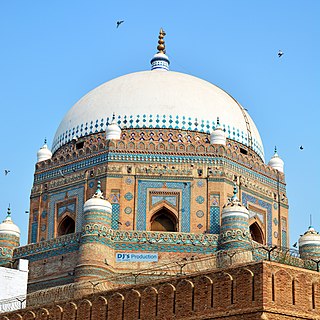Top Qs
Timeline
Chat
Perspective
Sufism in Punjab
Sufi tradition in Punjab From Wikipedia, the free encyclopedia
Remove ads
Sufism has played a major role in the history of Punjab. West Punjab, Pakistan is heavily influenced by Sufi Saints and major Sufi Pirs. The partition in 1947 led to the almost complete ethnic cleansing of Muslims from East Punjab. The Sufi shrines in the region continue to thrive, particularly among so-called ‘low’ caste Dalits that constitutes more than 30% of its population. After the partition the Dalit community took over the care of Sufi shrines in the East Punjab.[1]

Remove ads
History
Summarize
Perspective
The majority of the Sufis in eastern Punjab come from the Chamar and Chuhra caste. Through the teachings of Guru Ravidass, some of the Dalits connect to the Qadri and Chishtia Sufi Orders. The holy Dalit Sufi Saints of Punjab are buried in graves that are painted in green and their tombs are covered with green cloth. Many proclaim themselves as disciples of Abdul Qadir Gilani, Khawaja Moinuddin Chishti, Baba Farid and other famous Sufis.[2]
The relationship between Dalits and Sufism in India, particularly in Punjab, is explored in the documentary Kitte Mil Ve Mahi, produced in 2005 by Ajay Bhardwaj.[1][3]

The main Silsilas in Punjab include;
Qadri Noshahi
The Qadri Noshahi[4] silsila (offshoot) was established by Naushah Ganj Bakhsh of Gujrat, Punjab, Pakistan, in the late sixteenth century.
Sarwari Qadiri
Also known as Qadiriya Sultaniya, the order was started by Sultan Bahu in the seventeenth century and spread in the western part of Indian subcontinent. It follows most of the Qadiriyya approach. In contrast, it does not follow a specific dress code or require seclusion or other lengthy exercises. Its mainstream philosophy is contemplation of belovedness towards God.[5]
Remove ads
Culture
This section is empty. You can help by adding to it. (April 2025) |
Major Punjabi Sufis
The major Punjabi Sufi saints include:
- Sakhi Sarwar (1120 – 1181)
- Baba Farid (1173 – 1266)
- Jahaniyan Jahangasht (1308 –1384)
- Shaikh Jamali Kamboh (1470 – 1536)
- Shaikh Gadai Kamboh (1500 – 1574)
- Shah Hussain (1538 – 1599)
- Naushah Ganj Bakhsh ( 1552 – 1654)
- Ahmad Sirhindi (1564 – 1624)
- Bari Imam (1617 – 1705)
- Sultan Bahu (1628 – 1691)
- Shah Sharaf (1640–1724)
- Shah Inayat Qadiri (1643 – 1728)
- Bulleh Shah (1680 – 1757)
- Ali Haider Multani (1690 – 1785)
- Farad Faqir (1720 – 1790)
- Waris Shah (1722 – 1798)
- Hashim Shah (1735 – 1843)
- Saleh Muhammad Safoori (1747 – 1826)
- Mian Muhammad Bakhsh (1830 – 1907)
- Maula Shah (1836 – 1944)
- Khwaja Ghulam Farid (1841 – 1901)
- Ghulam Rasool Alampuri (1849 – 1892)
- Muhammad Iqbal (1877 – 1938)
- Sharif Kunjahi (1914 – 2007)
- Wasif Ali Wasif (1929 – 1993)
See also
References
Wikiwand - on
Seamless Wikipedia browsing. On steroids.
Remove ads
